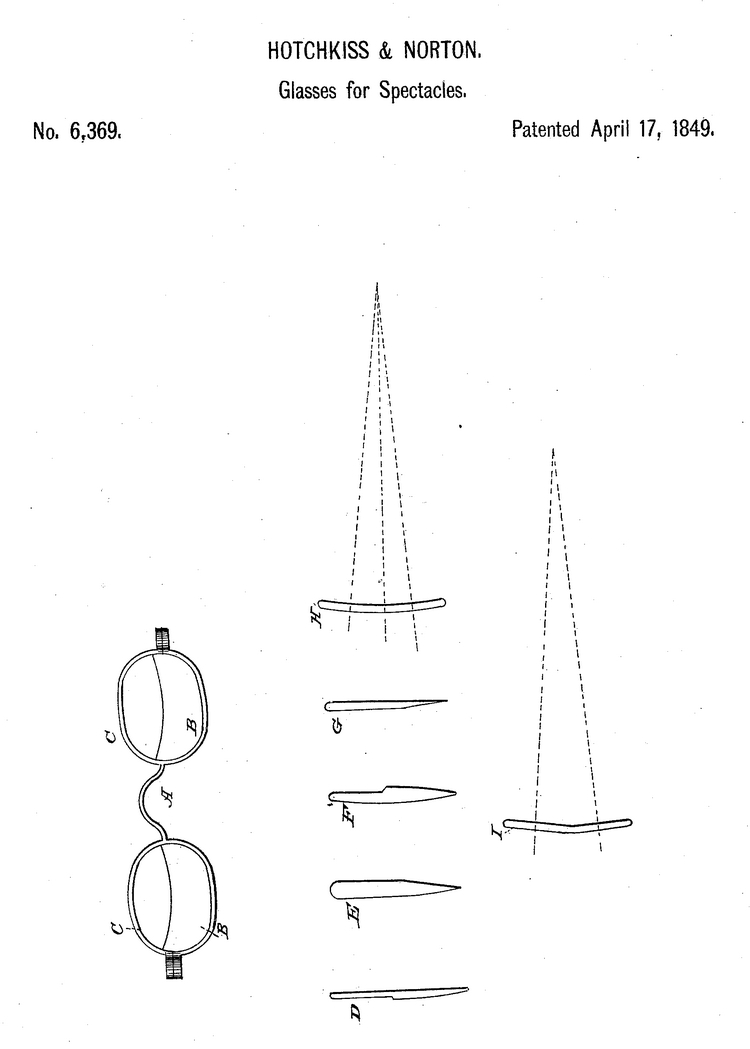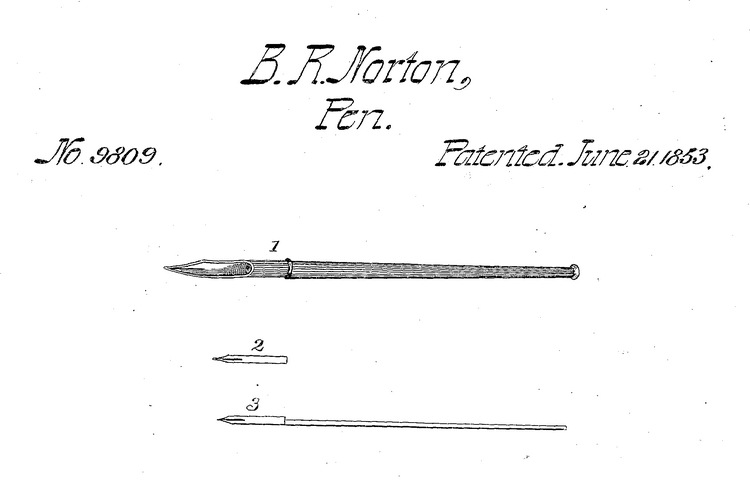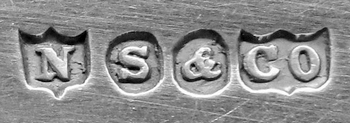Benjamin Reigel Norton
- Born: Sep 1817, New York
- Marriage (1): Louise Gardner about 1845 in Syracuse NY
- Died: 15 Jun 1902, Oakland CA
General notes:
Jeweler
Events in his life were:
- He worked circa 1840-1842 as a jeweler in Palmyra NY
- He was a partner in 1842-1844 with David Hotchkiss in Syracuse NY as HOTCHKISS & NORTON

- He worked in 1844-1849 as a jeweler in Syracuse NY as B. R. NORTON & Co.
- He was a partner circa 1848-1854 with Joseph Seymour in Syracuse NY as NORTON & SEYMOUR. 18

- He was issued patent number 6,369 on 17 Apr 1849
DAVID HOTCHKISS AND BENJAMIN R. NORTON, OF SYRACUSE, NEW YORK
SPECTACLE-GLASS
Specification of Letters Patent No. 6,369, dated April 17, 1849.
To all whom it may concern :
Be it known that we, David Hotchkiss and Benjamin R. Norton, of the city of Syracuse, in the county of Onondaga and State of New York, have invented a new and useful Improvement in Glasses for Spectacles; and we do hereby declare the following to be a full, clear, and exact description of the construction and operation of the same, reference being had to the annexed drawing, making part of this specification.
The nature of our invention consists in so constructing glasses for spectacles, that the upper portion is adapted to viewing objects at a distance and the lower portion to viewing objects near the eye.
In the annexed drawings, A represents a pair of spectacles having the lower portion (B) of the glasses convex, and the upper portion (C) a plane.
(D) is a vertical section of a glass having its upper portion a plane, and its lower portion a piano convex.
(E) is a section of a glass having its upper portion a plane and its lower portion a double convex.
(F) has its upper portion a piano convex, and its lower a double convex.
(G) has its upper portion plane, and its lower piano convex.
(H) represents a vertical section of a glass having its upper portion plane, and its lower a concavo convex, and so bent that the line of either portion forms an angle with that of the other at the center.
(I) is a section of a glass having its upper portion a plane, and the lower portion a piano convex, both inner surfaces being plane and forming an angle with each other of about 10 degrees.
The forms shown at D and F may be made by grinding. Those shown at (E and G) may be made by first grinding the convex surfaces in the usual manner, and afterward, the upper portion may be heated and forced, while in a plastic state, toward the center of the glass, thereby thickening the upper portion so that the plane surfaces may be ground to the focal point as represented. Those shown at (H and I) are made by first bending a plane glass so that the inner surfaces form any desired angle with each other, and the lower portion is then ground to any form suited to viewing near objects.
Persons wearing spectacles to view near objects, look over them, or remove them to view distant objects.
By the use of our glasses, both near and distant objects may be seen distinctly, without inconvenience, through the same glass. We are aware that the same object has been imperfectly accomplished by placing two pieces of glass in the same bow, the upper glass being plane and the lower being ground to any form suited to viewing near objects, an invention which we disclaim, and which is objectionable by having a joint between the two portions of glass, and directly in front of the sight.
The form shown at (I) we have found to be the best for use.
The precise mode of bending and grinding our glasses we do not deem necessary to explain, as our invention rests upon constructing glasses in such a manner that different portions of each glass are adapted to seeing objects at different distances, without regard to the mode by which it is done or the form given to the glass.
The utility of our invention consists in the convenience with which both near and distant objects may be seen with distinctness through the same glass.
What we claim as our invention and desire to secure by Letters Patent, isó
Constructing glasses for spectacles in such a manner that the upper portion of each glass is adapted to seeing distant objects; and the lower portion to seeing objects near the eye, the two portions being in one piece, substantially as above set forth.
David Hotchkiss
Benjamin R. Norton
Witnesses:
R. F. Stevens
Seymour H. Stone
- He appeared on the 1850 census taken at Syracuse NY, listed as a jeweler.

- He was issued design patent number 9,809 on 21 Jun 1853
BENJ. R. NORTON, OF SYRACUSE, NEW YORK
METALLIC-POINTED PEN.
Specification of Letters Patent No. 9,809, dated June 21, 1853.
To all whom it may concern:
Be it known that I, Benjamin E. Norton, of the city of Syracuse, in the county of Onondaga and State of New York, have invented a new and useful Improvement in Metallic-Pointed Gutta-Percha Pens; and I do hereby declare the following to be a full, clear, and exact description of the same, reference being had to the annexed drawings, making part of this specification.
My invention is constructed as follows: Prepare metallic molds, in halves, or as most convenient, the inside or matrix of which is of the shape and size of the pen to be made, having on one end a cylinder and piston for forcing the gum or composition of gums when in a plastic state, into the molds. The points, Figure 2, are prepared by soldering iridium onto gold or its alloy, or any other suitable metal, then ground, split, and worked as in the ordinary process of making gold pens. Solder a wire, Fig. 3, to the upper end of the points so prepared, leaving the wire of sufficient length to form a handle for the pen; put the points and wire, (after being attached,) into the molds, heat the gum to a plastic state, and press it into the mold with great force by means of the piston, which will cause the gum to completely envelop the wire handle and ribs, except their extreme ends, which must be protected by the molds. After the gum has become sufficiently cold, the whole may be removed from the molds, and will be found to possess all the durability of the gold, together with the ease and flexibility of the quill, at much less expense than the ordinary gold pen.
My invention is not confined to the precise metals indicated, but consists in attaching a metallic pen, with iridium points, to a wire handle, and covering, (by the process described or any analogous process,) the pen and handle with gutta percha, or other elastic gum, to give elasticity to the whole.
What I claim as my invention, and desire to secure by Letters Patent isó
A metallic pointed pen attached to a wire of the length required to form a handle or holder, when such pen and holder are covered from the top of the holder to near the nib of the pen by a coating of gutta percha, or india rubber of suitable thickness, made in the manner and for the purposes set forth.
Benjamin E. Norton
Witnesses:
E. F. Stevens
D. Hotchkiss

- He appeared on the 1870 census taken at Alameda, Alameda, CA, listed as a jeweler.
- He appeared on the 1900 census taken at Oakland CA, listed as a jeweler.
Benjamin married Louise Gardner about 1845 in Syracuse NY. (Louise Gardner was born on 20 Mar 1811 in Romulus NY and died on 26 Dec 1878 in Alameda, Alameda, CA.)
|





